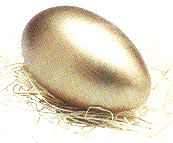
Easter Egg
[Home]

Eggs have been
associated with Easter for many centuries and are the most identifiable symbol
of Easter.
In the very early days eggs were decorated with bright colours to represent the
coming of spring and the growth of new plants and animals and used in egg
rolling or given away as gifts, sometimes between lovers and romantic admirers
much in the same way as Valentine gifts.
Different countries have different traditions for their egg decoration with gold
and silver favoured by Slavic people, crimson red to represent the blood of
Christ in Greece, green eggs for Holy Thursday in parts of Germany and Austria
and also in Austria plants are sometimes wrapped around eggs before they are
boiled.
It is also quite common in some countries for eggs to have their insides blown
out to leave the empty shell, which is then decorated and hung from shrubs and
trees during Easter week.
Eggs were also used in Easter sports with the Romans giving out eggs as prizes
in their celebratory Easter races and nowadays there are two common games the
Easter Egg Hunt and the Easter Egg Roll.
The rules of the Easter Egg Roll are simple - whoever can roll their egg the
furthest distance down a hill without it breaking is the winner. Although many
participants use the rolling as an excuse to crack the shell and eat the inside!
The Easter Egg Hunt involves lots of eggs being hidden around the house or
garden by the Easter Bunny before the children of the house get up for the day.
They are then invited to try and find all the eggs often with a chocolate egg as
the reward.